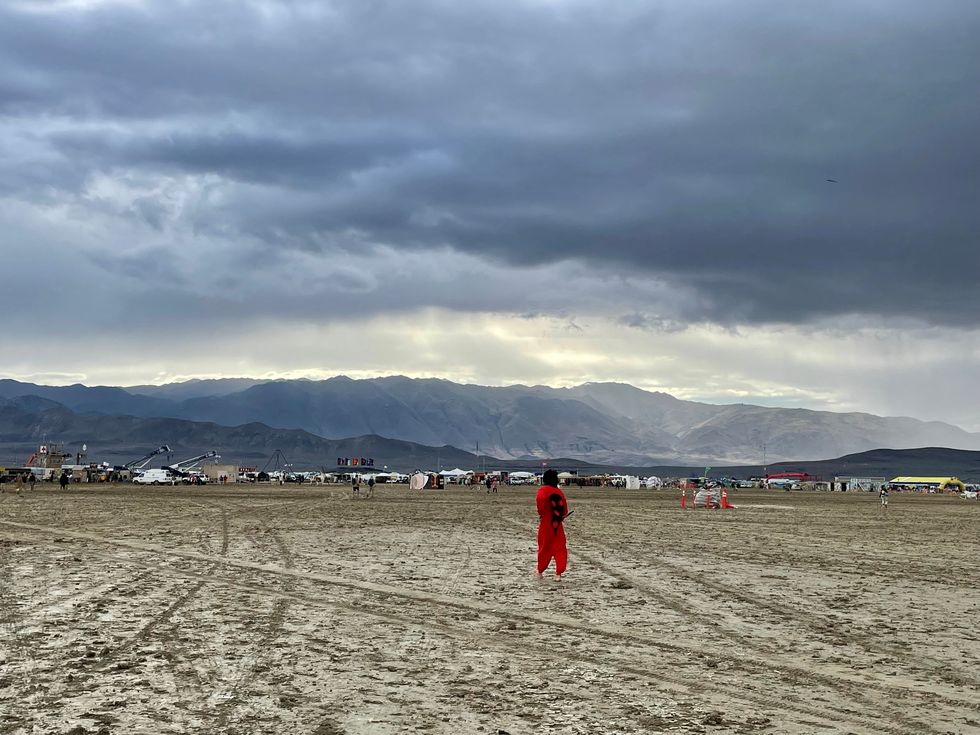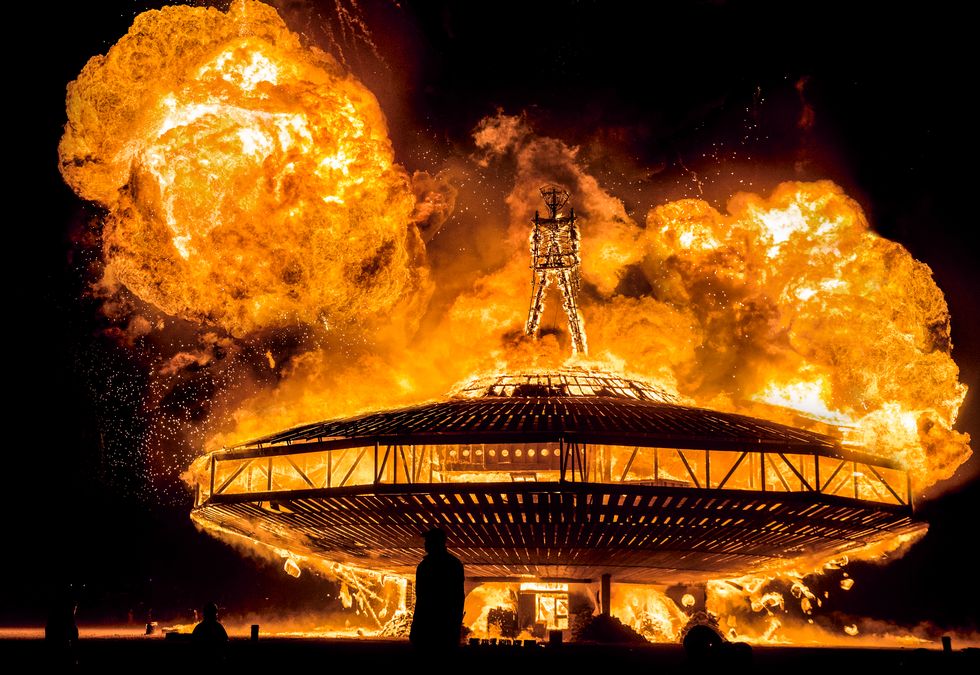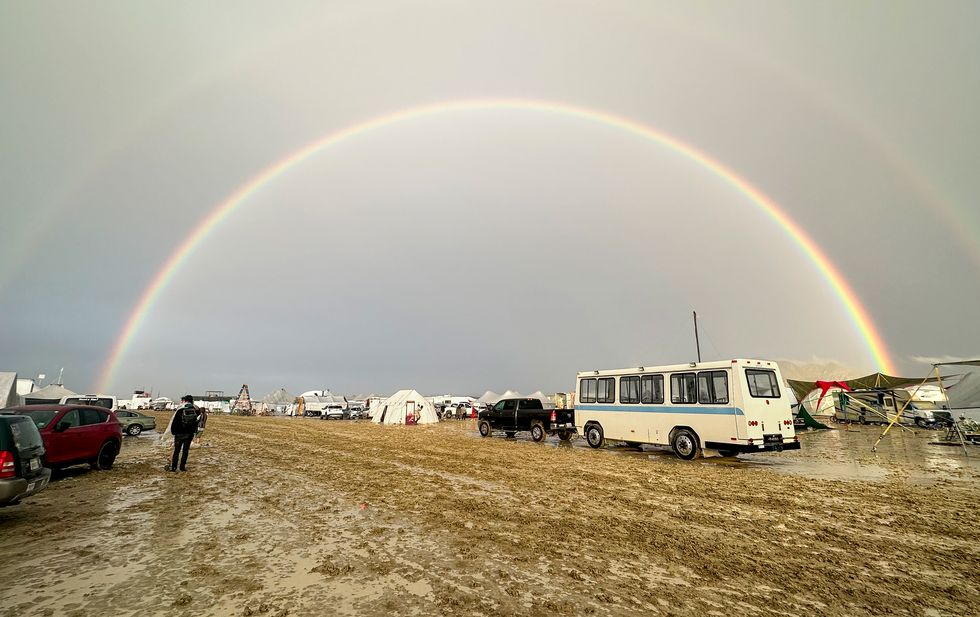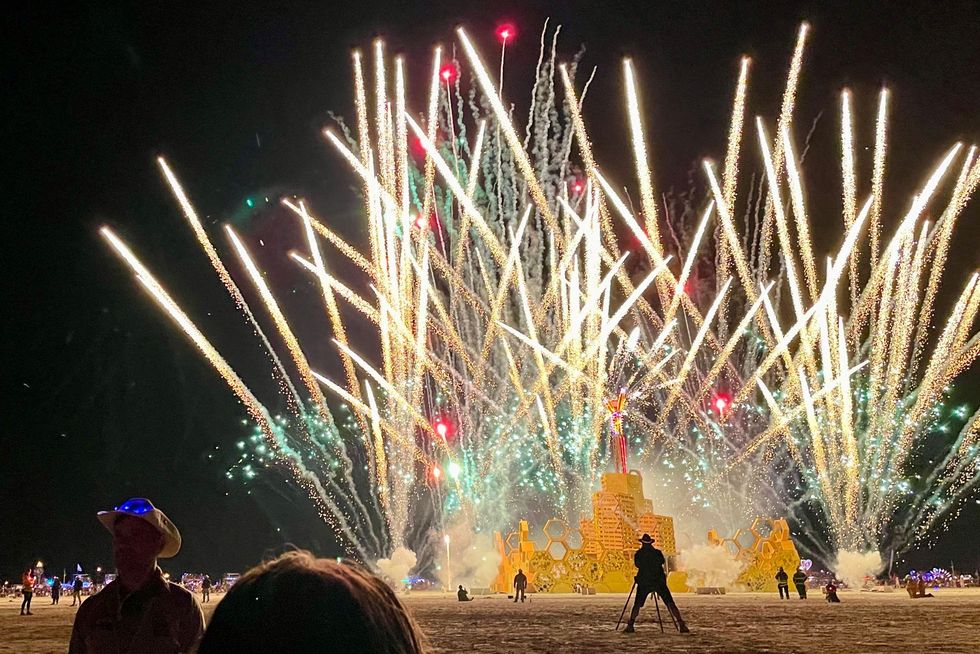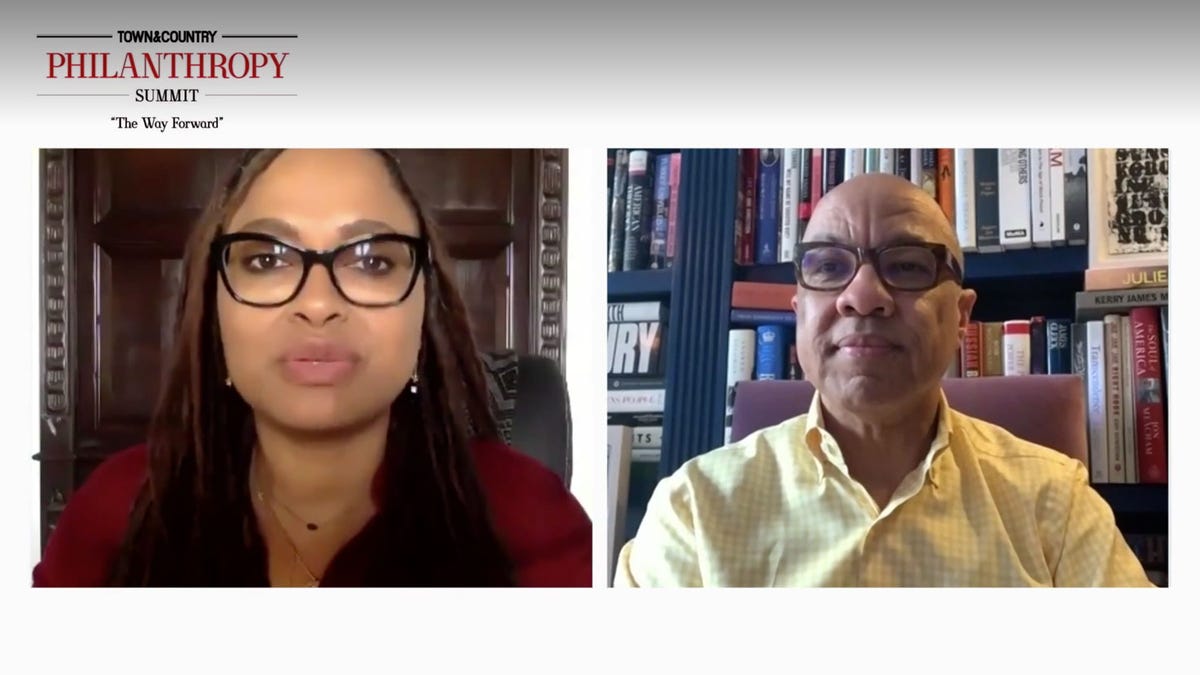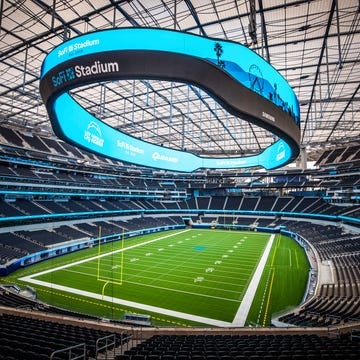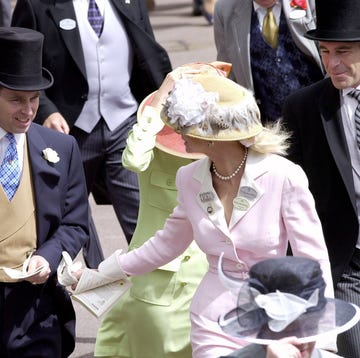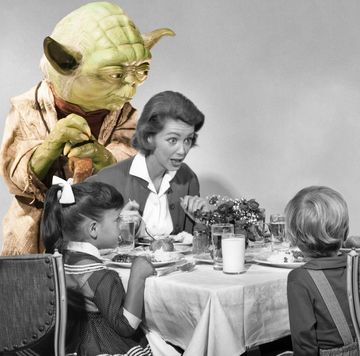A storm was coming.
Fausto Zapata had been telling everyone since he had arrived at Burning Man five days earlier. They laughed at him, started calling him “the meteorologist” because, um, what forecast was he looking at?
Dust storms were common in the desert, with winds cresting at 60 miles an hour. Temperatures could soar to 110 degrees. Lightning even. But heavy rain? That didn’t happen in Black Rock.
This was Zapata’s fourth Burning Man. Back in Los Angeles he co-owned an artisanal mezcal company, El Silencio, and a companion luxury resort in Oaxaca. He liked the finer things, but he didn’t mind roughing it. In fact, he relished the harsh conditions at Burning Man. He learned something new every year. Often the desert itself had been his best teacher.
This year he was in an RV in a camp not far from the esplanade, the main road in Black Rock City. The city itself was a marvel to Zapata, the way each year it essentially rose from the desert floor—the bed of an ancient inland sea—in the span of a few weeks and disappeared like a mirage just as quickly. It covered four square miles, with concentric streets splayed out in the shape of a clock face. At its center stood a 40-foot wooden figure. This was the eponymous man, and in two days the attendees would burn it, the climax of the event.
It was late afternoon, the time when the sun sinks behind the barren black hills and mutant vehicles prowl the playa, which is Burner parlance for the desert floor. Zapata loved the ingenuity that went into these vehicles—a disco-dancing chicken, a flaming octopus, a pirate ship with billowing sails, a Tiffany jewel box. Soon he’d be among them, headed on his bike with LED wheels to dance at a camp like PlayAlchemist. As the sun set, the music was already thumping, making the windows of his RV vibrate. And just beyond the city, in the Black Rock Range, thunderheads had begun to form. Zapata was right. You could smell it in the wind. A storm was on the way.
Black Rock Billionaires
The next morning, on the other side of Black Rock City, in a camp known as Walk-Ins, Brent Rose woke up to something he had never before experienced on the playa: cold. Usually the sun woke you up, the heat rising from the desert floor with eye-watering intensity. In fact, the year before had been so hot, Rose had asked himself if he’d ever be back. He had spent an entire day with a friend lying on a blow-up mattress in his tent in a near catatonic state, spritzing himself with a spray bottle every five minutes, counting the seconds until the sun went down. Which is why the cold this morning seemed eerie, ominous even. Rose, a writer, put on a windbreaker and ventured out to see the city, welcoming the familiar sound of the barkers calling out free facials and cocktails on the playa’s dusty streets.
A native of San Francisco, Rose had seen Burning Man change in essentially the same way the Bay Area had since his childhood in the ’90s: It had gentrified. The weeklong event had begun in 1986 on San Francisco’s Baker Beach; it attracted about 30 people to watch its founder, a Stetson-wearing hippie named Larry Harvey, burn an effigy to mark the end of a relationship. In 1991 Burning Man moved to the desert of northwestern Nevada, about two hours from Reno. The whole idea back then was anti-consumerism, to build a steampunk utopia where a software engineer or a school teacher could put on a fuzzy cowboy hat or a massive panda head and experiment with drugs, group sex, or just walking around half naked. Or completely naked. No money changed hands; the only things you could buy were coffee and ice, both provided by the organization, the Burning Man Project, which Harvey and the other founders turned into a nonprofit in 2014. Anything else was bartered.
Unlike, say, Coachella, there was no headliner, no provided entertainment. In fact, real Burners winced if you referred to it as a festival. The idea here was that everyone participated: That was the entertainment. You built your shelter or your transportation, or you offered a service: DJing, hosting the “Slut Olympics,” giving a lecture on queer theory, and then, after seven days of getting stoned, tripping on LSD, and enduring chapped lips and the thin layer of white alkaline dust that coated everything from your nostrils to your platform boots, you gathered around the titular Burning Man and watched it burn. Rose went every few years, beginning in the early 2000s, always staying in a tent with a rotating cast of friends. Sometime around 2011 he noticed a profound shift. Ticket prices skyrocketed and tech moguls like Elon Musk, Sergey Brin, Nicolas Berggruen, and Mark Zuckerberg were spotted on the playa.
At first the billionaires made a point of blending in, but then a new set started arriving on chartered jets with models, Hollywood starlets, and servants, known as sherpas. This gave rise to a phenomenon known as plug-and-play, a bougie turnkey experience of lavish RVs and air-conditioned yurts designed to look like Bedouin tents, but with chandeliers. Everything was provided: the goggles ringed in rhinestone, the precooked meals, even the drugs. Fees for these plug-and-play camps (one served lobster and steak tartare) could be as high as $100,000. The Burning Man organization tried to eliminate these camps in 2019—they went against the core principle of decommodification—but around the playa Rose could still see plenty of them organized in formations of RV armadas. Unlike a lot of Burners, he didn’t mind them. They often hosted the best parties and created the best mutant vehicles. Besides, wasn’t one of the event’s principles “radical inclusion”? Did that not also extend to tech bros? This year he decided to go at the last minute, which is why he ended up at Walk-Ins. This was the camp on the outer ring of Black Rock City, near the entrance gates. It’s where you ended up if you weren’t invited to one of the established camps (which sometimes require a full CV as part of the application process), or if you’d been to Burning Man so many times you didn’t care where you stayed.
By midmorning there were rumors of rain. Rose expected a light sprinkle, which sometimes happens in the desert, but by late afternoon the rain had picked up. Rose noticed that the cracks in the desert floor had filled with water and were now puddling up. He says, “I remember thinking, Huh, this could be more of a situation than I thought.” He retreated to a friend’s tent and spent the evening making cocktails, the rain escalating from a pitter-patter on the tent’s dome to a thundering drumbeat. When Rose decided to call it a night and made the walk back to his own tent—just 20 yards away—he was surprised to see several inches of standing water. “There’s part of you that’s like, It can’t flood much more than this,” he says. “But what does happen if it floods above the zipper line in my tent? What if we get five to six inches of water?”
Oontz-Oontz-in-Place
The next day, at dawn, the Black Rock Rangers, the organization’s “first response” team, went camp to camp with the news that law enforcement had implemented a shelter-in-place order. No one could leave the city. The rain had turned the playa into a mess. Walking in it was difficult and required putting a plastic bag over each shoe, and then a sock over that. Driving across the mud to the paved road five miles away was impossible. “The playa was just an absolute shambles,” Zapata says. “Everybody in their makeshift rainboots with garbage bags and socks on them, held together with duct tape, trying to push bikes around and not getting anywhere. It just became paralyzed.”
Zapata has regularly gone on mountain climbing expeditions that require weeks of meticulous planning, and he shifted into emergency mode, tallying how much water and food he had. Then he started thinking about the broader camp. And then Black Rock City itself. The pop-up city of 70,000 was incredibly remote—proper emergency services were an hour away—and there was no cell signal. (While a few Burners were on Starlink, most had no access to wifi.) “The biggest concern for me was people getting desperate and panicking, depending on how long this lasted,” he says, “because not only could no one leave, no one could really get in either until the weather lifted. And then the rumors started.”
Limited contact with the outside world means that wild speculation is part of the Burner experience. Typically the scuttlebutt is harmless—did you hear the one about Arnold Schwarzenegger crashing a Humvee?—but this year it was hard to separate truth from fiction. Word spread that the Centers for Disease Control had confirmed an ebola outbreak and that a private jet from Burning Man had been quarantined upon landing at LAX to prevent the spread of the disease. It mushroomed from there: FEMA was planning to air-drop food to the playa. President Biden had been briefed. The National Guard was on its way. Someone had died. (Some of the rumors were true. The president had been briefed, and someone had died: a 32-year-old named Leon Reece, of a drug overdose.) By this point the looming disaster at Burning Man had gone viral, generating international press coverage. The tone, however, was not concern. It was schadenfreude. Money, the TikTok commentariat cried, can’t save you from mother nature.
Bread & Circuses MMXXIII
On Saturday, September 2, Brent Rose woke to the sound of cars zooming through his camp. Walk-Ins is right next to the entrance gate, so hearing traffic wasn’t entirely unexpected, but it sounded as if cars and trucks were coming dangerously close.
Rose hurriedly unzipped his tent door and stumbled out into the morning heat. To his mild alarm, trucks and RVs were making a desperate attempt to escape Black Rock City, defying the order to shelter in place. He watched in shock as a veteran Burner with a hammer started chasing those fleeing. “I fucking hope you die of cancer,” he yelled at the cars, which he couldn’t catch. But that was the only “Mad Max scene,” as he put it, that Rose witnessed. As the playa dried out and the city came back to life, the Lord of the Flies scenario many had feared didn’t materialize. In fact, Rose saw the opposite: camps coming together, opening up their RVs to people who had gotten soaked in their tents.
At a camp called Hex Collective, CJ Yu, a Los Angeles film executive, was worried about the plug-and-play next door. “Everyone kind of assumed those camps would be the least prepared, like, would they have enough water?” But Yu’s camp traded extra gasoline for 10 pounds of fresh tuna, from which the camp chef, who had worked at the French Laundry in Napa Valley, made dinner and lunch, giving leftovers away. In the meantime the plug-and-play camp had improvised a dome out of metal framing and plastic, and as darkness fell they turned the music up and hosted a dance party that didn’t end till dawn. Yu thought of a proverb from Roman times: “Bread and circuses, those are the two things humans crave. If you entertain people, they forget about their problems.”
Two days later Zapata, Yu, and about 40,000 other Burners gathered at center camp and watched the Man burn. (Rose and perhaps half of Black Rock City had left early.) The next morning the mass exodus began, a five-mile traffic jam of RVs, Toyota Tacomas, and Subarus headed to the “default world” of New York, Chicago, São Paulo, Paris, and points in between. The playa teemed with assorted jetsam: tents caked in mud, rugs buried in the dirt, PVC pipe, the flame-charred carcass of a trailer. Once back in range of cell coverage, Burners’ phones lit up with messages of concern. Were they all right? Had there really been an ebola outbreak?
“It was kind of funny to live through this moment where the entire internet was wrong,” says Jack Dreifuss, an angel investor from San Francisco. “The world basically thought we were having the worst time, and sort of hoping we were, and the reality couldn’t have been more different.”
Most Burners weren’t aware of how many headlines this year’s event had generated or of the “eat the rich revelries,” as one New York Times writer labeled the gleeful shitposting. Dreifuss chalked some of it up to “jealous bitches who wish they were there.”
“The beautiful part of Burning Man is that no one gives a fuck. I’ve seen Elon Musk there. I’ve spent time with people who actually are tech billionaires. We all use the same porta-potties. We all have to endure the heat and the rain,” he says. “It’s a great equalizer.” Like the weather itself, most Burners took the online hate in stride, shrugging it off as ignorance about the event. Extreme weather is part of the experience every year. “Even if you don’t take a single drug, the event is like a psychedelic medicine experience, where it’s hard and it’s brutal and you go through some bullshit,” Dreifuss adds. “But then the other side of it is incredible: sunrises and music.”
And yet the future of Burning Man is in question. For environmentally conscious Burners (which is most of them), there’s the uncomfortable fact that the event has a negative impact on the planet: a carbon footprint of 100,000 tons of carbon dioxide, more than 90 percent derived from travel to and from the Black Rock Desert. The organizers have set a goal to be carbon negative by 2030, but there are open discussions about how much longer the Nevada desert can host them. A hotter planet means more precipitation, meaning this year’s torrential showers could be a harbinger of things to come.
Back in L.A., Zapata wasn’t sure how he knew it would rain, or what forecast he was looking at that no one else seemed to see. The storm was unexpected, but his camp was prepared, and, as it turned out, so was everyone else. If anything, it gave him a greater sense of camaraderie with his fellow Burners. He recalls the morning after the rain finally stopped, when the playa began to dry. He emerged from his RV and checked his phone. With a Starlink connection, he wasn’t completely isolated from the outside world. A friend had sent him a screenshot of a news story. Social media was full of memes roasting Burning Man as another Fyre Fest, the music festival that famously imploded in the Bahamas in 2017.
Zapata cracked open a beer and surveyed the scene. He chuckled. Like the ancients, Burners had left behind evidence of their presence in the land. A mud sculpture stood out. It was a giant hand, its middle finger extended to the world.
The photograph featuring the "Insanity" sculpture is also by Anders Overgaard.
This story appears in the December 2023/January 2024 issue of Town & Country, with the headline "Burningheimer!"

Jesse Hyde is a journalist based in Salt Lake City. His work has also appeared in Rolling Stone, Vanity Fair, the Atlantic, GQ, and Bloomberg Businessweek.

